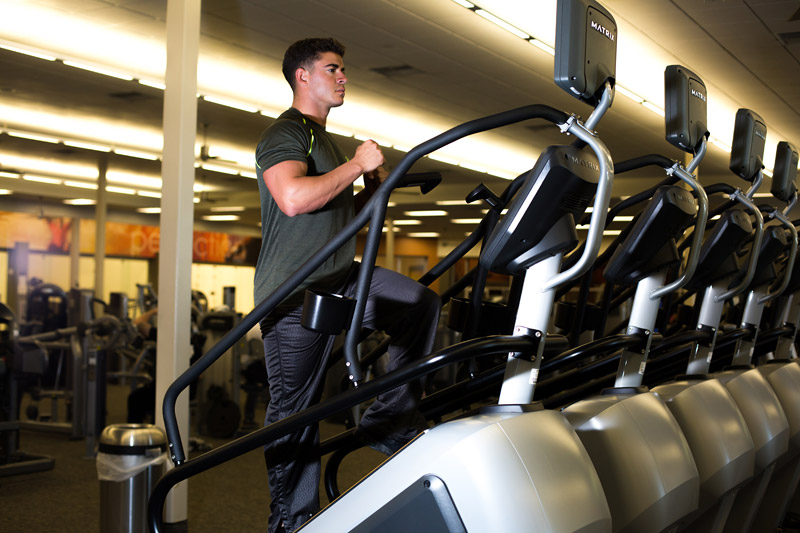
Walk into any gym and you’ll find two distinct groups of gym-goers: cardio bunnies and strength junkies.
Generally, if you ask those cardio hoppers what brings them to the treadmill, spin bike or elliptical, it’s their desire to lose weight or, more accurately, fat. However, the strength lovers, by and large, have already hit their fat-loss goals.
After all, in one Journal of Sports Science and Medicine study, people who performed a simple 20-minute, high-intensity strength workout burned an average of 15 calories per minute – nearly twice as many as during a long run on the treadmill.
But, like we’ve said before, even if pure cardio isn’t the ultimate way to lose weight, it does have its pros – from which even weight-room lovers can benefit. And, nestled between all of those people who not-so-fondly refer to the treadmill as the “dreadmill,” are people who legitimately love their cardio workouts. Long cardio sessions help them clear their heads or feel more powerful. Maybe they love to explore their cities on the trail. Maybe you’re one of those cardio-loving people.
So how do you make cardio work for your fat-loss goals? Take a lesson from the weight room. Here, experts share the lessons of strength training that can make your cardio routine a veritable fat-fighter.
One reason strength training is so great for fat loss is that it results in excess post-exercise oxygen consumption, aka EPOC, says certified strength and conditioning specialist Jacque Crockford, a certified personal trainer with the American Council on Exercise. Basically, EPOC is the calories your body burns as it works to recover in the hours (and even days) after your sweat session.
But cardio can result in EPOC, too. You just have to raise the intensity, says Pat Gilles, Wisconsin-based certified strength and conditioning specialist and personal trainer. “Increasing exercise intensity from 50 to 75 percent of VO2 max [a measure of intensity] results in almost doubling of EPOC.”
However, since it’s physiologically impossible to do anything with your max effort for very long, it’s important to crank the intensity in intervals.
There are tons of ways to do this. For instance, if you like to run on the trails, you can incorporate hills or even fartleks, in which you sprint, say, to the next mailbox, and then recover with a slower jog until you’re ready for your next sprint. If you’re on the elliptical, spin bike or stair climber, you can toy with both resistance and speed. When performing intervals, remember that the longer your high-intensity sprints, the longer your recovery intervals will need to be, Crockford says.
One great high-intensity interval training, or HIIT, protocol is the Tabata, and it can be applied to any cardio workout. According to research published in Medicine & Science in Sports & Exercise, the protocol (which only takes four minutes) can burn more fat than a traditional steady state 60-minute aerobic workout. To complete a Tabata cardio workout, go at your max effort for 20 seconds, rest for 10 seconds and then repeat that circuit for a total of eight times. The trick is to really feel like you can’t possibly work any harder during your high-intensity bouts. Before starting a max-intensity Tabata-style workout, talk to your doctor to make sure it’s safe for your heart.
2. Focus on Your Form

We worry a lot about form when it comes to strength training, which makes sense: You don’t want your form breaking down when you have dumbbells over your face. But using correct form is just as important during cardio sessions, and not just because it can help keep you safe and injury-free. It can help you burn more calories with every bead of sweat, Gilles says.
Think about it: If you lean onto the handrails while using the stair climber or hang from them as you lean back to power walk up a hill on the treadmill, you are making things easier on yourself. Put another way, your body isn’t working as hard or burning as many calories as it could be, he says.
Remember, while intensity is a great way to increase caloric burn, if the intensity is so high than you can’t complete it without shortcuts in your form and technique, your intensity is too high. Think form first. Always.
3. Turn Your Cardio Machine Into a Resistance One

“When we build lean muscle mass, we increase our resting metabolic rate,” Crockford says. “That means we use more calories at rest.” And while, depending on how you do it, cardio can actually lead to muscle loss, if you do it the right way, you can build muscle on your favorite cardio machine or on the trail.
A simple way is by increasing resistance. The harder your arms and/or legs have to work during every movement, the more opportunity you have to build lean, metabolically active muscle.
What’s more, if you’re a fan of cardio machines, a few tweaks to your exercise technique can completely change their muscle-building potential, Crockford says. For instance, to build upper-body strength, she recommends using only your arms to move the elliptical machine. “On the treadmill, put it on a slow speed with a high incline and perform walking lunges in between running or walking intervals,” she says. Or, you can push through only one leg while on the elliptical or stationary bike.
Just pay minimal attention to the number of calories your machine says you’re burning, Gilles says. Their calorie-counters are infamously inaccurate and might not accurately represent your fat-loss progress.
4. Try New Forms of Cardio

“The more efficient you are at anything, the fewer calories you burn doing it,” Gilles says. That’s the beauty of exercise: Your body adapts. But it’s also why most strength programs involve switching things up every four to six weeks.
And so should your cardio routine. “To burn more calories, do something that you are not efficient at,” he says. That doesn’t mean that you have to give up your elliptical sessions, but what about trying that rowing machine one day per week? Or maybe it’s time to hit up a cardio workout class that you’ve been eyeing? And, of course, if you’re willing to change up speeds, incline and resistance, your tried-and-true elliptical can still challenge your body in new ways.





Leave a Reply